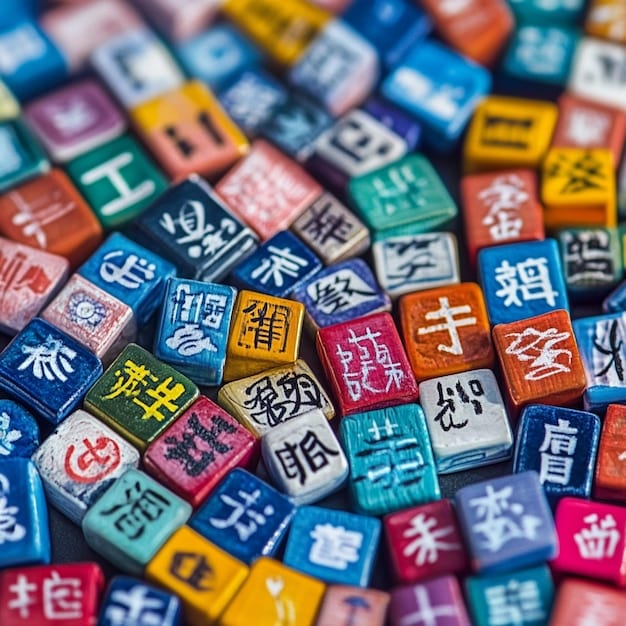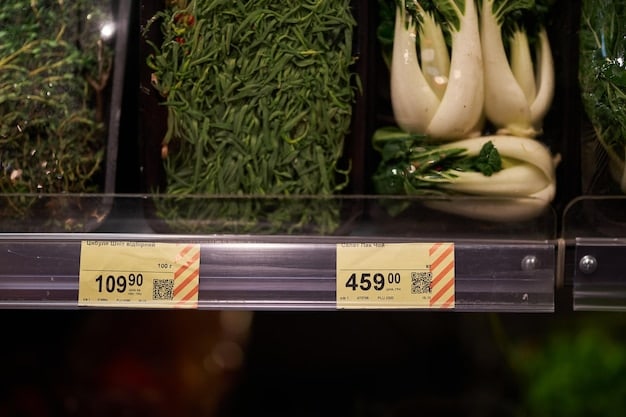Decoding Japanese Product Labels: A 2025 Guide for US Shoppers

Decoding Japanese product labels in 2025 is crucial for US shoppers to avoid counterfeits and ensure they are purchasing authentic, safe, and high-quality Japanese goods, understanding key indicators and resources for verification.
Navigating the world of Japanese products can be exciting for US shoppers, but it’s also essential to know how to protect yourself from counterfeit goods. Decoding Japanese product labels: A 2025 guide for US shoppers to avoid counterfeits will equip you with the knowledge you need to shop confidently and ensure you’re getting the real deal.
Understanding the Basics of Japanese Product Labels
When shopping for Japanese products, understanding the labels is the first step in ensuring authenticity. Japanese product labels contain a wealth of information, from ingredients and manufacturing dates to certification marks and usage instructions. Familiarizing yourself with these elements will significantly reduce the risk of purchasing counterfeit goods.
Key Components of a Japanese Product Label
Japanese product labels typically include several important components, often written in Japanese. Here’s what to look for:
- Product Name (製品名): Identifies the product’s name.
- Ingredients/Materials (原材料名): Lists all ingredients or materials used in the product.
- Manufacturer (製造者) / Distributor (販売者): Indicates the company that manufactured or distributed the product.
- Country of Origin (原産国名): Specifies the product’s country of origin.
Understanding these basic components can serve as a starting point for determining the authenticity of a product.
Common Symbols and Markings
In addition to text, Japanese product labels often feature symbols and markings that denote quality, safety, or compliance with industry standards. For instance, the Japan Industrial Standards (JIS) mark indicates that the product meets specific quality benchmarks. Knowing what these symbols mean can provide extra assurance about the product’s legitimacy.

By learning to recognize these key elements, US shoppers can begin to navigate the complexities of Japanese product labels and avoid potential pitfalls.
The Rising Threat of Counterfeit Japanese Goods
The market for counterfeit goods is a global issue, and Japanese products are not immune. Counterfeit items, ranging from cosmetics and electronics to food and pharmaceuticals, can pose significant risks to consumers. These fake products often lack the quality control and safety standards of genuine items.
Identifying Counterfeit Products
Recognizing counterfeit products requires vigilance and an understanding of common red flags. Some indicators include:
- Unusually Low Prices: If the price seems too good to be true, it probably is.
- Poor Packaging: Counterfeit items often have substandard packaging with misspellings or blurry printing.
- Missing or Incorrect Labels: Genuine Japanese products have specific labeling requirements that counterfeiters often overlook.
By being aware of these signs, consumers can reduce their chances of buying fakes.
Health and Safety Risks
Counterfeit products can pose serious health and safety risks. Fake cosmetics may contain harmful chemicals, while counterfeit electronics may lack essential safety features. In the case of food and pharmaceuticals, the risks are even greater, as these products may contain incorrect ingredients or be contaminated.
It’s crucial to source products from reputable sellers and to always check for signs of authenticity before making a purchase. This proactive approach can help protect consumers from the dangers associated with counterfeit goods.
Key Labeling Laws and Regulations in Japan
Japan has strict labeling laws and regulations designed to protect consumers and ensure product safety and quality. These laws cover a wide range of products, from food and cosmetics to electronics and textiles. Understanding these regulations can help US shoppers identify authentic products and avoid counterfeits.
Overview of Key Laws
Several laws govern product labeling in Japan. Some of the most important ones include:
- Food Sanitation Act: Regulates the labeling of food products to ensure they are safe and accurately described.
- Pharmaceutical Affairs Act: Sets standards for the labeling of pharmaceuticals and medical devices.
- Consumer Products Safety Act: Requires manufacturers to label products with safety information to prevent accidents.
These laws mandate specific information to be included on product labels, helping consumers make informed purchasing decisions.
Compliance and Enforcement
Japanese authorities take compliance with labeling laws seriously. Regular inspections and penalties for non-compliance help maintain high standards. Companies that violate these laws may face fines, product recalls, and damage to their reputation.
US shoppers can often verify compliance by looking for specific certification marks and detailed product information on the label. This provides an added layer of assurance when purchasing Japanese products.
Decoding Specific Product Categories
Different product categories have unique labeling requirements and potential pitfalls for counterfeit goods. Understanding the specifics for each category can help US shoppers make informed decisions and avoid fakes.

Food and Beverages
Food and beverage labels in Japan must include detailed information about ingredients, nutritional content, and expiration dates. Look for the following:
- Expiration Date (消費期限 or 賞味期限): Indicates the “use by” or “best before” date.
- Ingredients List (原材料名): Lists all ingredients in descending order by weight.
- Allergen Information (アレルギー表示): Highlights common allergens such as wheat, soy, and dairy.
Cosmetics and Skincare
Cosmetics and skincare products require a list of ingredients, manufacturer information, and usage instructions. Key things to watch out for include:
- Full Ingredient List (全成分表示): Specifies all ingredients used in the product.
- Manufacturing or Batch Number (製造番号): Helps track the product back to the manufacturer.
- PAO (Period After Opening) Symbol: Indicates the shelf life after the product has been opened.
Electronics and Gadgets
Electronics labels should include the manufacturer’s name, model number, and safety certifications. Look for:
- Model Number (型番): Identifies the specific model of the product.
- PSE Mark (電気用品安全法): Indicates that the product complies with Japanese safety standards for electrical appliances.
- Warranty Information (保証): Provides details about the warranty coverage.
By understanding these category-specific requirements, US shoppers can better assess the authenticity and safety of Japanese products.
Tools and Resources for Verification
Various tools and resources can help US shoppers verify the authenticity of Japanese products. These resources provide access to valuable information and can assist in identifying potential counterfeits.
Online Databases and Websites
Several online databases and websites offer information about Japanese products and manufacturers. Some useful resources include:
- Japan Brand Protection Association (JBPA): Provides information about anti-counterfeiting measures and genuine Japanese brands.
- JETRO (Japan External Trade Organization): Offers market information and support for international trade with Japan.
- Official Manufacturer Websites: Often provide authentication guides and product information.
These resources can help consumers verify product details and identify authorized distributors.
Mobile Apps and QR Code Scanners
Mobile apps and QR code scanners can provide instant access to product information. Many Japanese products feature QR codes that link to official websites or product details.
- QR Code Readers: Available on most smartphones, these apps can scan QR codes on product labels.
- Translation Apps: Can translate Japanese text on labels into English for better understanding.
Using these tools can quickly provide valuable insights into product authenticity and safety.
Future Trends in Anti-Counterfeiting Measures
As technology evolves, so do anti-counterfeiting measures. In the future, expect to see more advanced techniques used to protect Japanese products from counterfeiting.
Blockchain Technology
Blockchain technology offers a secure and transparent way to track products from manufacturer to consumer. By recording each step of the supply chain on a blockchain, it becomes easier to verify the authenticity of a product and prevent counterfeiting. This technology ensures that every product’s journey is traceable and verifiable, significantly reducing the risk of fake goods.
AI and Machine Learning
Artificial intelligence (AI) and machine learning can analyze product labels and packaging to identify subtle signs of counterfeiting. These technologies can detect anomalies that human inspectors might miss, providing an additional layer of security. AI algorithms can quickly process vast amounts of data, identifying patterns and discrepancies that indicate a product may not be genuine. This proactive approach can help prevent counterfeit goods from reaching consumers.
“`html
| Key Point | Brief Description |
|---|---|
| 🔎 Label Basics | Understand key elements like ingredients, manufacturer, and origin. |
| ⚠️ Counterfeit Risks | Be alert for low prices, poor packaging, and missing labels. |
| ✅ Compliance Laws | Japan’s laws ensure product safety; look for official marks. |
| 📱 Verification Tools | Use databases, apps, and QR codes to verify product authenticity. |
“`html
Frequently Asked Questions
The main components include the product name, list of ingredients, manufacturer’s name, and country of origin. These details are crucial for verifying authenticity.
Look for unusually low prices, poor packaging, misspellings, and missing or incorrect labels. These are common signs of counterfeit products.
Counterfeit products can contain harmful chemicals, incorrect ingredients, or lack essential safety features, posing serious health risks to consumers.
Resources like the Japan Brand Protection Association (JBPA) and JETRO offer information about genuine Japanese brands and anti-counterfeiting measures.
Blockchain and AI will provide transparent tracking and sophisticated analysis to identify and prevent the sale of counterfeit Japanese products.
“`html
Conclusion
In conclusion, understanding and decoding Japanese product labels: A 2025 guide for US shoppers to avoid counterfeits is essential. By staying vigilant, utilizing available resources, and keeping abreast of evolving anti-counterfeiting technologies, US shoppers can confidently purchase authentic Japanese goods and protect themselves from the risks associated with counterfeit products.
“`html





